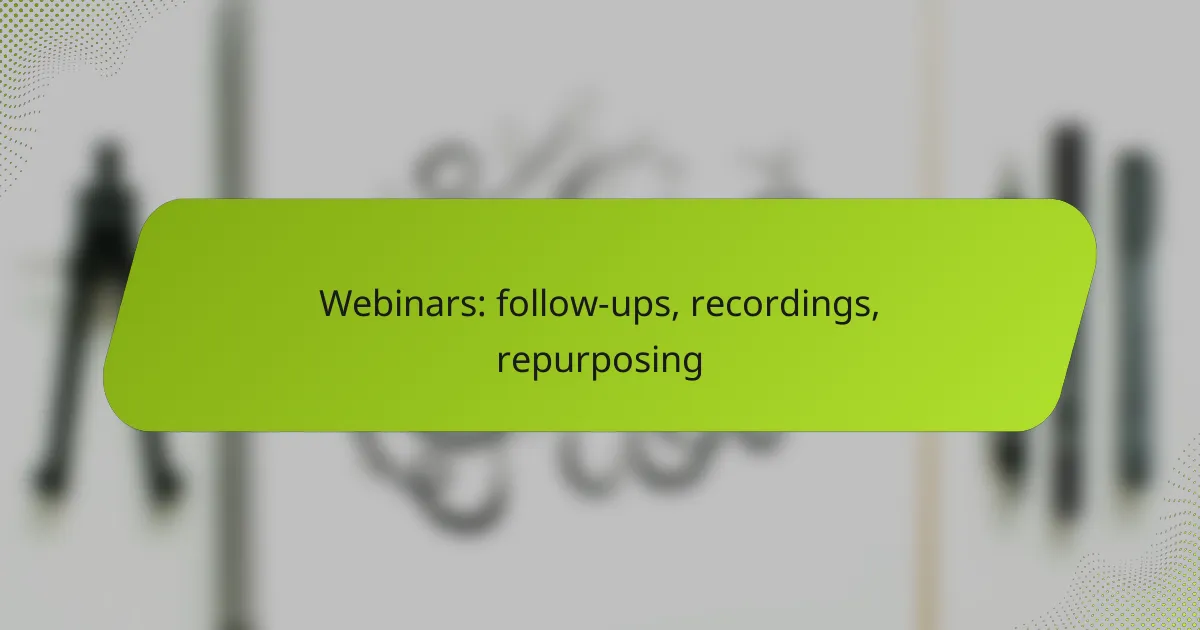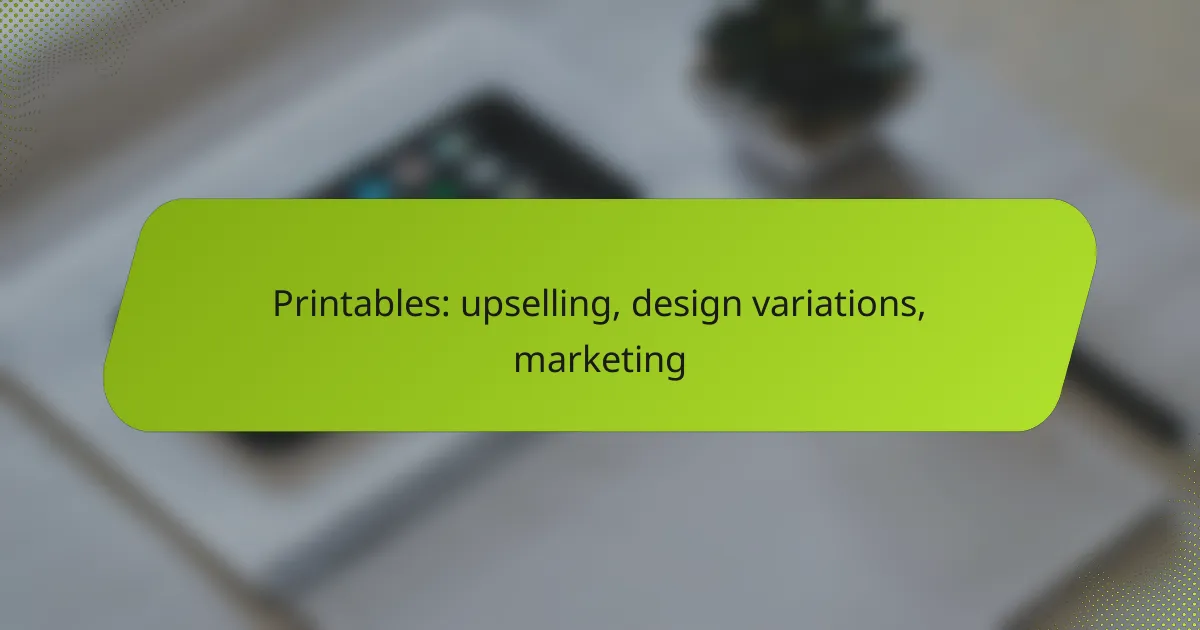Webinars offer a unique opportunity to engage audiences, but the impact can be maximized through effective follow-ups and strategic repurposing of content. Timely communication with participants enhances their experience and increases the likelihood of future interactions. Additionally, high-quality recordings and thoughtful repurposing can extend the reach of your message, allowing you to connect with diverse audiences across various platforms.

How to effectively follow up after webinars in the UK?
Effective follow-ups after webinars in the UK involve timely communication and targeted engagement strategies. This ensures that participants feel valued and are more likely to convert into customers or repeat attendees.
Email follow-up strategies
Sending a follow-up email within 24 to 48 hours after the webinar is crucial. This email should thank participants for attending, provide a summary of key points, and include a link to the webinar recording. Aim for a friendly yet professional tone to maintain engagement.
Consider segmenting your email list based on attendee behavior, such as those who asked questions or downloaded resources. Tailor your messages to these segments for higher relevance and impact.
Utilizing CRM tools for engagement
CRM tools can streamline your follow-up process by tracking attendee interactions and preferences. Use these tools to automate follow-up emails and reminders for future events, ensuring no one slips through the cracks.
Additionally, analyze engagement metrics from your CRM to identify which topics resonated most with your audience. This data can inform future webinars and help refine your content strategy.
Personalized content delivery
Personalization is key to effective follow-ups. Use data from your CRM to customize content based on attendee interests and behaviors. For instance, if a participant showed interest in a specific topic, send them related articles or resources.
Consider creating tailored offers or exclusive content for attendees as a way to encourage further engagement. This could include discounts on related products or access to premium content, enhancing the value of your follow-up efforts.
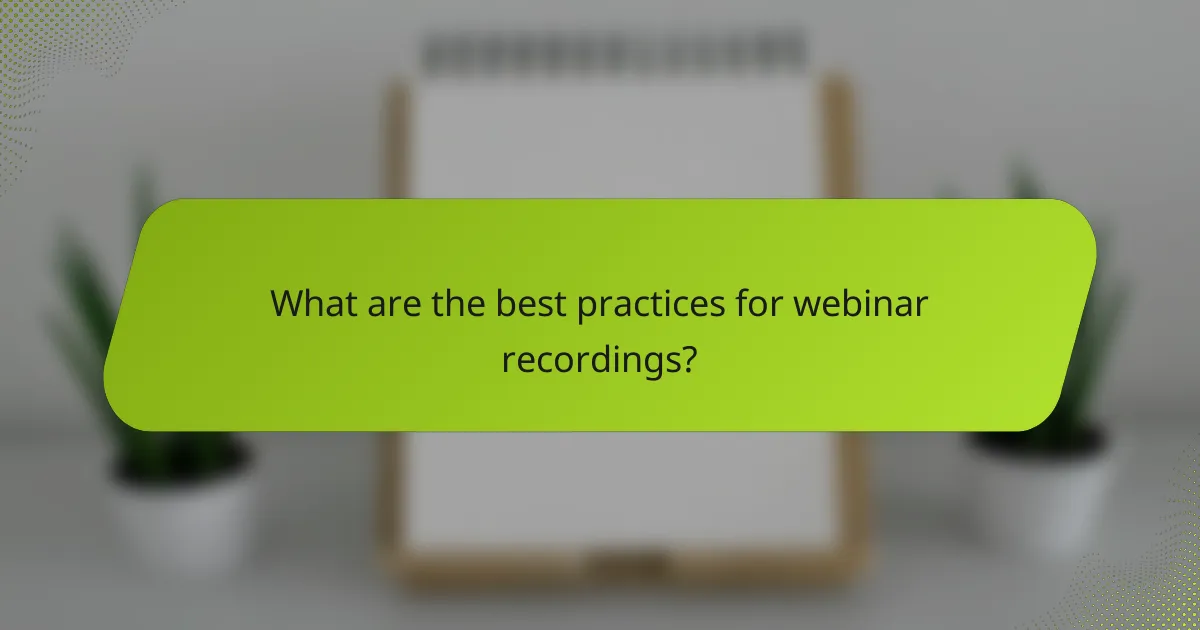
What are the best practices for webinar recordings?
Best practices for webinar recordings involve selecting appropriate software, ensuring high-quality editing, and providing accessible storage options. These elements help create a polished final product that can be effectively repurposed for future use.
Choosing the right recording software
Selecting the right recording software is crucial for capturing high-quality audio and video. Popular options include Zoom, OBS Studio, and Camtasia, each offering unique features such as screen sharing, multi-camera support, and built-in editing tools.
Consider your specific needs, such as ease of use, compatibility with your operating system, and budget. Many software options offer free trials, allowing you to test functionality before committing to a purchase.
Editing tips for professional quality
Editing is essential for enhancing the professionalism of your webinar recordings. Use software like Adobe Premiere Pro or Final Cut Pro to trim unnecessary parts, improve audio clarity, and add graphics or captions.
Focus on maintaining a consistent visual style and ensuring that any transitions are smooth. Aim for a final product that is engaging but not overly flashy, as this can distract from the content.
Storage and accessibility options
Choosing the right storage and accessibility options ensures that your webinar recordings are easy to access and share. Cloud storage services like Google Drive, Dropbox, or Vimeo provide reliable platforms for hosting your videos.
Consider the privacy settings and sharing capabilities of your chosen platform. For instance, if you want to limit access to specific audiences, ensure that your storage solution allows for password protection or private links.

How to repurpose webinar content for maximum impact?
Repurposing webinar content effectively can significantly extend its reach and value. By transforming recordings and materials into various formats, you can engage different audiences and reinforce key messages.
Creating blog posts from webinar transcripts
One of the most straightforward ways to repurpose webinar content is by converting transcripts into blog posts. Start by summarizing the main points discussed during the webinar, ensuring that the content flows logically and remains engaging for readers.
Consider breaking the blog post into sections that correspond to different topics covered in the webinar. This not only improves readability but also allows you to optimize each section for search engines using relevant keywords.
Developing social media snippets
Social media snippets are a great way to share key insights from your webinar with a broader audience. Extract compelling quotes, statistics, or highlights and craft short posts that can be shared across platforms like Twitter, LinkedIn, and Facebook.
Use engaging visuals or infographics to accompany your snippets, as these can increase engagement rates. Aim for concise messages that encourage followers to watch the full webinar or visit your website for more information.
Transforming webinars into online courses
Webinars can serve as foundational material for online courses. Start by identifying the main themes and learning objectives from your webinar, then expand on these topics with additional resources, quizzes, and assignments.
Consider structuring the course into modules that follow the original webinar’s flow. This allows participants to build on their knowledge progressively. Platforms like Teachable or Thinkific can help you host and manage your online course effectively.
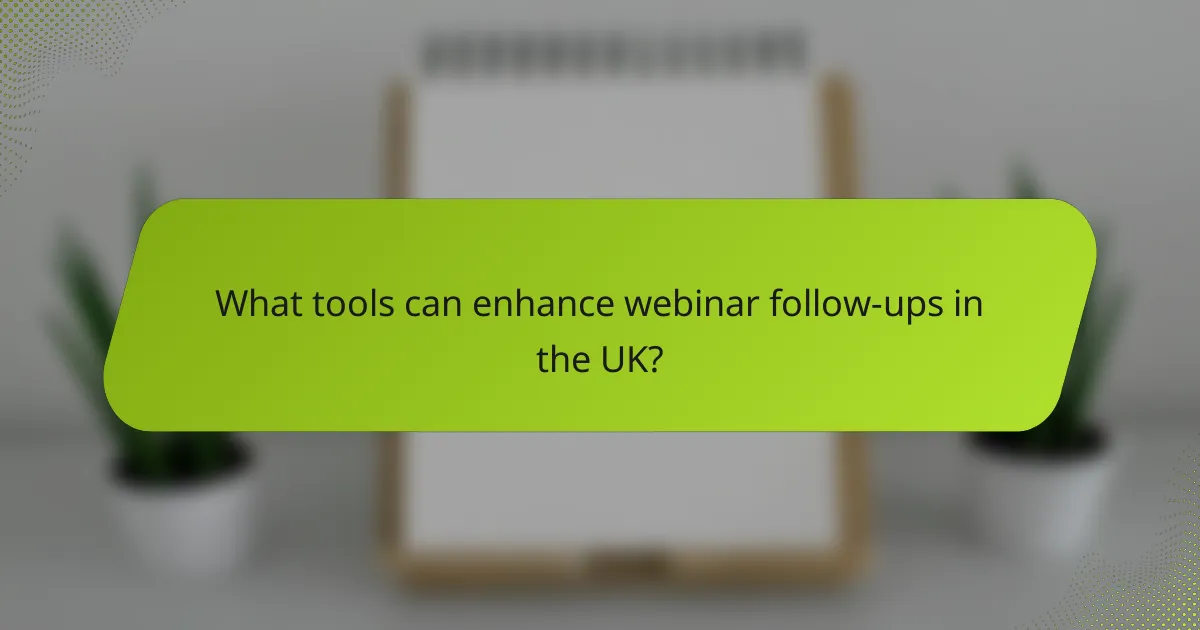
What tools can enhance webinar follow-ups in the UK?
To effectively enhance webinar follow-ups in the UK, utilizing the right tools can streamline communication and improve engagement. Tools like Mailchimp and HubSpot offer automation and tracking features that can significantly boost your follow-up efforts.
Using Mailchimp for automated emails
Mailchimp is a powerful tool for automating follow-up emails after webinars. With its user-friendly interface, you can easily set up automated email sequences that send personalized messages to attendees, thanking them for their participation and providing additional resources.
Consider segmenting your audience based on their engagement level during the webinar. For instance, you might send a different follow-up email to those who actively participated versus those who attended passively. This targeted approach can increase the likelihood of further engagement.
Implementing HubSpot for tracking
HubSpot is ideal for tracking attendee behavior and engagement post-webinar. By integrating HubSpot with your webinar platform, you can monitor metrics such as email open rates, click-through rates, and overall engagement levels, allowing for data-driven follow-up strategies.
Utilize HubSpot’s reporting features to analyze which content resonates most with your audience. This insight can inform future webinars and follow-up content, ensuring that you continually refine your approach based on actual user behavior.
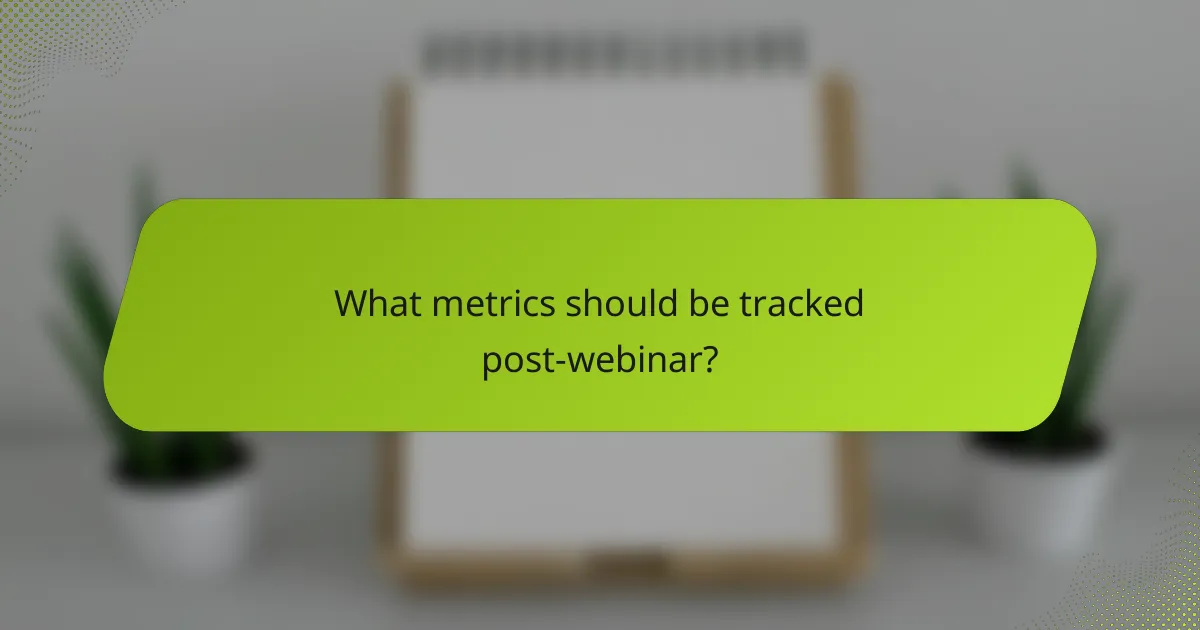
What metrics should be tracked post-webinar?
Post-webinar metrics are essential for evaluating the effectiveness of your event. Key metrics include engagement rates and conversion tracking, which provide insights into audience interaction and the success of your follow-up strategies.
Engagement rates analysis
Engagement rates measure how actively participants interacted with your webinar content. This includes metrics such as attendance duration, chat participation, and poll responses. Aim for at least 50% of attendees to stay for the entire session to indicate strong engagement.
To analyze engagement, consider tools that track viewer behavior during the webinar. Look for trends, such as peak interaction times or specific topics that generated more questions. This data can help refine future content and presentation styles.
Conversion tracking
Conversion tracking assesses how many attendees took a desired action after the webinar, such as signing up for a newsletter or making a purchase. A good conversion rate typically falls between 5% and 20%, depending on your industry and the offer presented.
To effectively track conversions, implement unique tracking links or codes for webinar attendees. This allows you to measure the impact of your webinar on sales or lead generation. Regularly review these metrics to adjust your marketing strategies and improve future webinars.
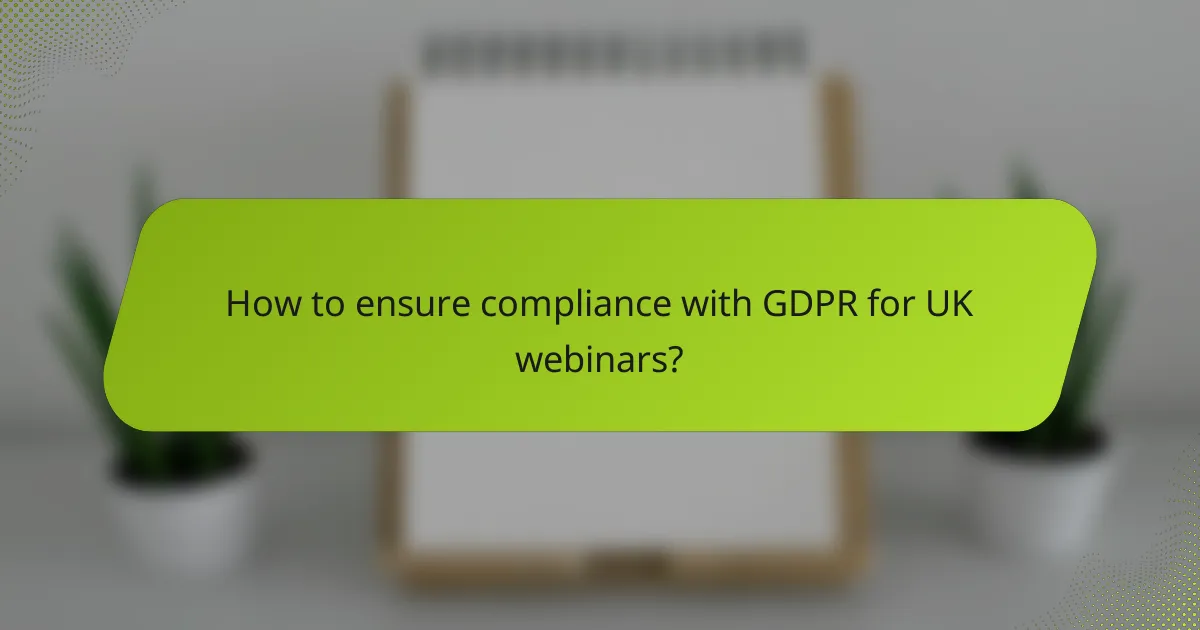
How to ensure compliance with GDPR for UK webinars?
To ensure compliance with GDPR for UK webinars, organizations must prioritize data protection and privacy. This involves obtaining explicit consent from participants before collecting their personal data and ensuring that data is processed securely and transparently.
Data collection best practices
When collecting data for webinars, limit the information gathered to what is necessary for the event. This typically includes names, email addresses, and any specific preferences related to the webinar content. Avoid collecting excessive data that may not be relevant to the event.
Utilize secure methods for data collection, such as encrypted forms or secure registration platforms. Regularly review and update your data collection practices to align with GDPR requirements and best practices.
Consent management strategies
Implement clear consent management strategies by providing participants with straightforward options to agree to data collection. Use checkboxes that are not pre-ticked, ensuring that consent is given freely and explicitly. Inform participants about how their data will be used and stored.
Maintain a record of consent for each participant, including the date and method of consent. Regularly audit your consent management processes to ensure compliance and address any changes in regulations or best practices.

What are the emerging trends in webinar technology?
Emerging trends in webinar technology focus on enhancing user engagement and accessibility. Innovations include advanced interactive features, integration with social media platforms, and the use of artificial intelligence for personalized experiences.
Interactive features in webinars
Interactive features in webinars significantly enhance participant engagement. Tools such as polls, Q&A sessions, and live chats allow attendees to actively participate rather than passively consume content. This interaction can lead to higher retention rates and a more dynamic learning environment.
When implementing interactive features, consider the audience’s preferences and the webinar’s objectives. For instance, using polls can gauge understanding in real-time, while Q&A sessions can address specific concerns. Aim for a balance that encourages participation without overwhelming attendees.
Common pitfalls include overloading the session with too many interactive elements, which can distract from the main content. Instead, focus on a few key features that align with your goals. A checklist for effective interactivity might include: defining clear objectives, selecting appropriate tools, and testing features beforehand to ensure smooth operation.
